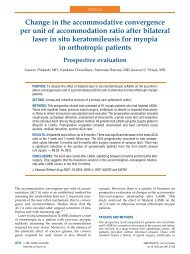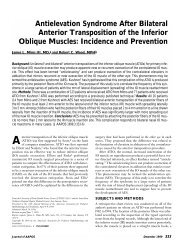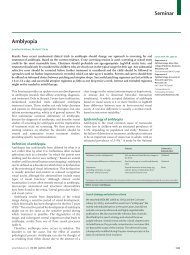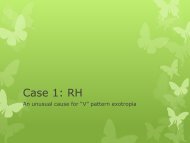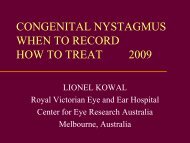What's new AAPOS 2008 - The Private Eye Clinic
What's new AAPOS 2008 - The Private Eye Clinic
What's new AAPOS 2008 - The Private Eye Clinic
Create successful ePaper yourself
Turn your PDF publications into a flip-book with our unique Google optimized e-Paper software.
initial positive response to medication with sustained benefits and 45% of the patients.<br />
Carbamazepine was effective in the greatest number of patients. Baclofen showed no<br />
treatment success. <strong>The</strong> authors suggested that a trial of one or more medications<br />
should be performed in patients with SOM.<br />
Changes in the functional binocular status of older children and adults with<br />
previously untreated infantile esotropia following late surgical realignment.<br />
Murray ADN, Orpen J., Calcutt C.<br />
J <strong>AAPOS</strong> 2007; 11: 125-129.<br />
<strong>The</strong> authors evaluated 17 patients aged eight years and older with a history of untreated<br />
esotropia present within the first six months of life. All had visual acuity of 20/30 or<br />
better in the worse eye, monocular optokinetic asymmetry, and binocular function<br />
assessments pre-and postoperatively. All were aligned within eight^ of orthotropia. 15<br />
of 17 patients acquired postoperative binocular function with Bagolini lenses and 13 of<br />
17 demonstrated an increase in the binocular visual field. <strong>The</strong> authors conclude that<br />
these patients derive functional benefits with late surgical realignment.<br />
Accommodative ability in exotropia: Predictive value of surgical success.<br />
Somer D, Demirice S, Cinar G, Duman S.<br />
J <strong>AAPOS</strong> 2007 Oct 11(5) 460<br />
Dynamic retinoscopy was performed preoperatively on 47 pts with basic X(T) with the<br />
capacity for fusion who were undergoing a first surgery. <strong>The</strong> patients were divided into<br />
two groups: those with “equal effective accommodative response” and those with an<br />
“unequal accommodative response between” the two eyes. <strong>The</strong>y then either had BLR<br />
or R&R. Sixty-eight percent of pts (32) had a difference in accommodative amplitudes<br />
between the two eyes. <strong>The</strong> data suggests that these patients did better with R&R than<br />
BLR. <strong>The</strong>y conclude a decrease accommodative response of the nondominate eye<br />
may be a predicting factor on the surgical success.<br />
Variability of Stereoacuity in Intermittent Exotropia.<br />
Hatt SR, Mohney BG, Leske DA, Holmes JM.<br />
Am J Ophthalmol. <strong>2008</strong> Jan 15 [Epub ahead of print]<br />
PURPOSE: Distance stereoacuity is used to monitor deterioration of intermittent<br />
exotropia (IXT), but variability of stereoacuity has not been studied rigorously. <strong>The</strong><br />
purpose of this study was to assess the variability of stereoacuity over one day in<br />
children with IXT. DESIGN: Prospective cohort study.<br />
13



